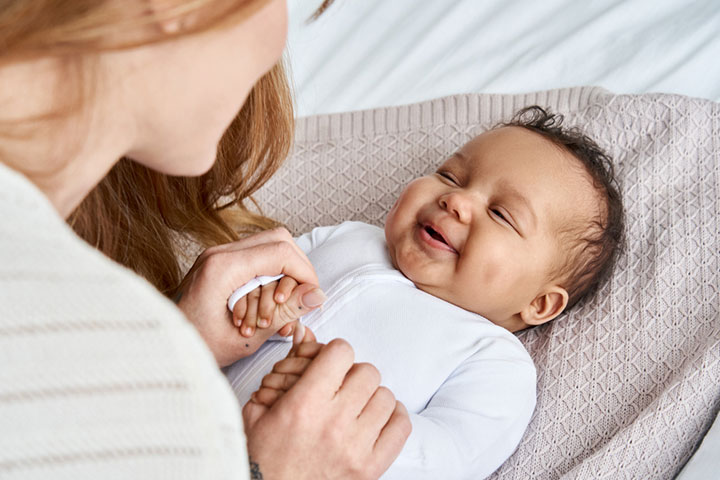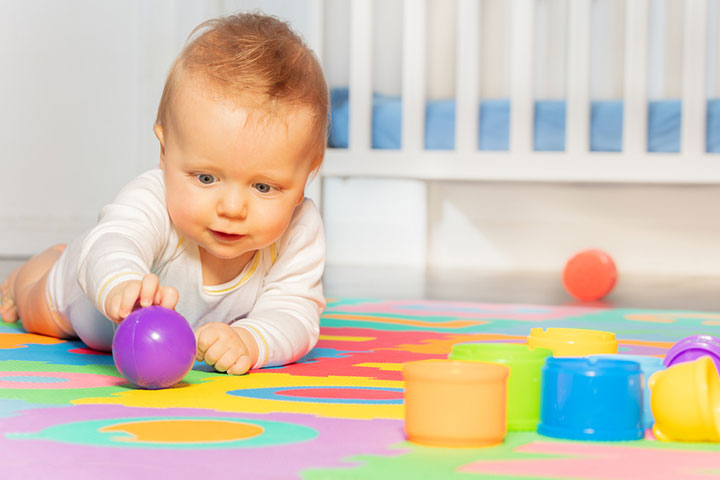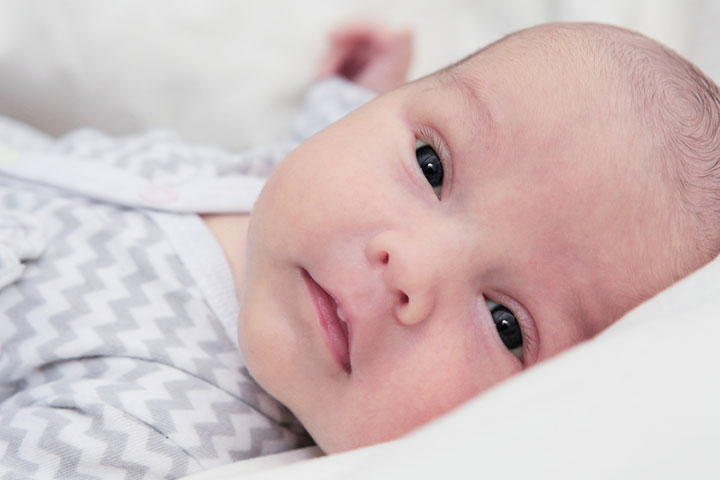Tips To Improve Developmental Milestones in A 6-Month-Old
When you observe your 6-month-old’s development, you’ll see that your little one is developing not just physically but also mentally. Your infant appreciates your presence at this age, enjoys admiring themselves in the mirror, and can messily eat semi-solid food.
If you’re curious about what more your newborn has in store for you at six months of age, keep reading. This post explains the developmental milestones your six-month-old infant should achieve in terms of mental, physical, and social development.
A 6-Month-Old’s Milestones Chart
| Achieved developmental milestones | Emerging developmental milestones |
|---|---|
| Eats select vegetables and fruits | Can eat a wider range of fruits and vegetables |
| Rolling over front to back and back to front | Will learn to get into the sitting position |
| Has raking grasp – can use all fingers to hold | Will develop pincer grasp – using index finger and thumb to hold |
| Practices basic cause and effect | Will utilize cause and effect for complex actions |
| Recognizes faces of primary caregivers | Will communicate through gestures with familiar faces |
| Makes simple vowels and consonant sounds | Will make more complex sounds |
| Rolls in both directions | Will roll into various positions such as sitting and crawling |
| Stretches to reach objects | Will crawl to reach and grasp objects |
| Sleeps for several consecutive hours in the night | Will have extended night sleep with less feeding breaks |
| Better color vision and depth perception | Can identify wider range of colors and perceive depth better |
A 6-Month-Old’s Developmental Milestones
Here we have categorized the developmental milestones into three categories: cognitive, physical, and social and emotional.
Cognitive Developmental Milestones
These milestones relate to your six-month-old baby’s brain development, intelligence, and thinking prowess.
- More curious: He has a new sense of fascination towards the environment, and he touches and holds things that fascinate him (1).
- Cause and effect: Your six-month-old baby will test the outcomes of several actions, and gauge your reactions.
- Basic vowel and consonant sounds: You notice that when you talk to your baby, he responds with “Ah”, “Eh”, or “Bh” sounds. This is because he is slowly grasping verbal communication.
- Imitates sounds: Since the baby has better sound interpretation skills, he will make efforts to imitate sounds he hears by babbling (2). It is mostly words and noises that the parents or caregivers make or the toy sounds.
- Responds to his name: Until now, you perhaps struggled to draw his attention with his name. But a six-month-old remembers the sound of his name and interprets it.
- Better self-consciousness:Responding to one’s name is the first step towards self-awareness. This becomes evident when you notice how he admires himself in the mirror. Babies at this age adore their reflection and glee on seeing it. They do not get confused on seeing their mirror image, which indicates improved discerning powers of the brain.
Physical Developmental Milestones
This category contains growth landmarks associated with the baby’s physical growth and gross motor capabilities.
- Good color vision and depth perception:One of the major physical development at six months are the baby’s eyes. The little one has improved color vision palette and can discern between two shades of colors (3) and therefore, loves looking at high contrast objects and brightly colored story books. He also has a superior perception of depth and distance, helping him judge objects and distances accurately. He can track objects, and you will notice that he stares at a rolling ball until it comes to a halt.
- Improved hand-eye coordination: Better vision leads to more precise functions of the hand. Six months onwards, babies are adept at extending their hands to grab objects even if they are moving. Once they hold an object, they observe it carefully, and may also pass it from one hand to another.
- Holds objects with all fingers: It is called a raking grasp, and the baby uses this to grasp small or tiny objects (4). The fingers are dexterous and if your toddler is formula-fed, then you will notice that he now holds his feeding bottle with ease.
- Sits without support: A six-month-old has stronger back muscles that are capable of supporting his full body weight. He may not get into a sitting position on his own, but he does not topple once he is sitting.
- Supports head: The baby has not just strong back muscles but also firm neck muscles. When you pick your six-month-old, his neck holds his head and may extend it in the direction in which he is moving. The baby will also turn his head to look at objects beyond his field of vision.
- Rolls in both directions: The little one takes advantage of strong back and neck muscles by learning to roll in both directions – from his back to his tummy, and vice versa.
- Supports weight when held vertical: The baby cannot stand on his own, but when held vertically, he will support his weight on his legs and will bounce up and down. This developmental milestone lays the foundation for subsequent landmarks such as standing and walking.
- Sleeps for six to eight hours: Sleeping in blocks of six to eight hours every night is normal for babies at six month (5). The little one may wake up for a feed once in a while, but not as often as before.
- Ready for solid food: A six-month-old has a sharper sense of taste, and his digestive system is all set to digest the first solid food. Babies also develop the chewing and biting reflex on the completion of six months (6).
Nupur, a mother from Georgia, US, says “Lila (her daughter) started eating solids little by little at 6.5 months of age, and now at 13 months, she eats almost everything we do, including 3 sit down meals a day (i).”
Social And Emotional Developmental Milestones
This development helps infants form a social bond with key people in their family.
- Responds to other’s emotions: You notice the first signs of empathy in your baby’s behavior. He will react to sad or happy expressions, especially his primary caregivers’. He could stop whatever he is doing and may be sad on seeing another infant crying.
- Different vocal expressions: There are different exclamations for various expressions and may cry differently when hungry , soiled, or feeling uncomfortable. In many cases, he would have a particular vocal expression for a particular emotion.
- Recognizes familiar faces and panics when with a stranger: The six-month-old greets known faces with an adorable smile, while when left in a company of a stranger he panics and wails. The infant understands that unlike with a stranger, a familiar face signifies safety, warmth, and food.
- Plays with parents/primary caregivers: The baby shows an acute inclination to play only with his parents and primary caregivers, and at most with a sibling.
These are the common milestones for a six-month-old baby. Each baby is unique and may take his/her time to develop. However, you must be alert for any signs of developmental delay and shortcomings in the baby.
When To Be Concerned?
If the baby is not developing at a normal pace, then he will show the following developmental backlogs:
- Stays stiff or droopy: The infant’s muscles appear stiff as if gone into a spasm or are so loose that his limbs droop. He will also have trouble supporting his head when lifted from a lying down position.
- Makes no vocal sounds, does not respond to noises: As mentioned above, babies do not talk at this age but can make noises. An inability to use vocal chords could be a precursor to a speech problem. Also, if the baby does not respond to parents’ voices or loud noises, then it could be a sign of hearing issues.
- Does not respond to familiar faces: A six-month-old would smile at his parents, and other familiar people such as a grandparent. Babies recognize familiar faces and get excited on seeing them after a long interval. A lack of reaction in such cases would indicate vision or cognitive problems.
- Does not play or displays abnormal/poor motor skills while playing: Babies love playing with toys and staring at colorful storybooks. They will not hesitate to grasp things in their hands and explore and comprehend the purpose of the object. Lack of interest in play and deficient motor skills such as a weak grip are indicators of a developmental delay.
The American Academy of Pediatrics recommends screening the baby at regular intervals for a timely diagnosis of delay, which can help cure or manage the condition better.
7 Tips To Improve The Development Of Your Six-Month-Old
Adopting proper parenting techniques can stimulate the baby’s growth through activities that appeal to him and help nurture his skills:
- Active play time with conversations: Do not just be a spectator while playing with your baby. Make it interactive by addressing the baby and referring with names. By doing so, you are stimulating the baby’s listening skills, while also sharpening his memory.
- Read and explore outdoors: Take your baby to the garden and read a colorful storybook to him. Take the baby to the garden so that he can see the vivid colors. Reading and exploring stimulates the baby’s vision, and the visual cortex in the brain, subsequently boosting his visual memory.
- Tummy time is important: Tummy time helps strengthen and tone various muscles, and makes the baby agile in his movements, thereby improving his standing and walking.
- Feed the baby finger foods: Your baby can eat solid food, so it is important you introduce vegetables and fruits in his diet. Consult a pediatrician about a balanced diet for the baby.
Ellie Polly, a mother of two from the UK, records what her six-month-old baby eats in a day. She starts his day with 9 ounces of formula in the morning. For breakfast, he is given baby porridge with strawberries. He is then fed two bottles of milk, one at around 11 am and the second at 2 pm For dinner, he is fed sweet potato and broccoli as finger food, along with a puree. He is given one last milk bottle before sleeping at 6 pm (ii).
- Social interactions are essential: It is important that your baby meets new people since that will help exercise his social skills.
- Baby cereals: Opt for iron-fortified cereals for babies when they start solids. This helps maintain their required iron levels for proper development. Make sure to choose the ones without added sugars or salt, and better avoid the ready-to-eat variants. Start with single-grain cereals such as rice, oats, and barley and later offer two or more together.
- Be vigilant of food allergies: Babies may develop severe allergies to some foods such as cow milk, soy, eggs, and peanuts. It is essential to introduce a single new food at a time to identify allergy-causing agents.
Reaching six months brings about a significant difference in a baby’s overall development. As you introduce solid foods to your 6-month-old, make sure to follow a nutritious meal plan alongside breastfeeding with the mother’s breast milk to aid in their growth and development. Further, you may indulge in conversations with them to hone their listening and speaking abilities, give them regular tummy time, and encourage outdoor walks and social interactions to promote social and memory skills. Finally, remember to be observant of any developmental delays and be sure to speak to your baby’s doctor if you think they are not developing at the right pace.
Key Pointers
- Babies at six months old become curious, do different things to gauge reactions, can create and imitate sounds, and respond to their names.
- At this age, babies have better hand-eye coordination, can sit without support, roll in both directions, and can support their head and weight when held.
- They are ready for solid foods and can sleep for six to eight hours at night.
- At this stage, they can empathize with others, vocally express their feelings through different sounds, recognize people, and love to play with caregivers.
- Stiff or limp muscles, lack of vocal sounds or response to familiar faces, and poor motor skills can be signs of developmental delay.
Watch this insightful video to compare typical and atypical development in a 6 month old baby side by side. Gain valuable knowledge on what to look for and how to help your baby reach their milestones.














